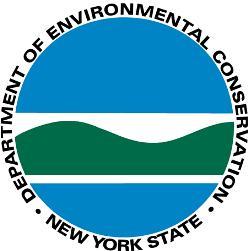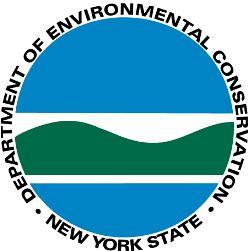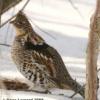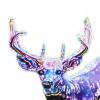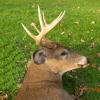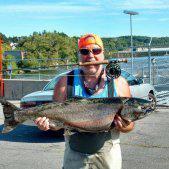Author Name: John Burmeister
Motorists should be especially alert for moose on roadways in the Adirondacks and surrounding areas at this time of year, warns the New York State Department of Environmental Conservation (DEC).
Early fall is the breeding season for moose in northern New York. During this time moose are wandering looking for mates, leading them to areas where they are not typically seen. While this improves the opportunities for people to enjoy sighting of a moose, it also increases the danger of colliding with one on the roadway.
Moose are much larger and taller than deer. Their large body causes greater damage, and, when struck, their height often causes them to impact the windshield of a car or pickup truck, not just the front of the vehicle. In 2010, three moose vehicle accidents were reported in New York. Fortunately, there has not been a human fatality from an accident with a moose.
Moose are most active at dawn and dusk, which are times of poor visibility. Moose are especially difficult to see at night because of their dark brown to black coloring and their height - which puts their head and much of their body above vehicle headlights.
DEC advises motorists to take the following precautions to prevent moose vehicle collisions:
· Use extreme caution when driving at dawn or dusk, especially during this time of year;· Reduce your speed, stay alert, and watch the roadsides;· Slow down when approaching moose standing near the roadside, as they may bolt at the last minute when a car comes closer, often running into the road;· Moose may travel in pairs or small groups, so if a moose is spotted crossing the road, be alert for others that may follow;· Make sure all vehicle occupants wear seatbelts and children are properly restrained in child safety seats;· Use flashers or a headlight signal to warn other drivers when moose are spotted near the road;· Motorcyclists should be especially alert for moose;· If a moose does run in front of your vehicle, brake firmly but do not swerve. Swerving can cause a vehicle-vehicle collision or cause the vehicle to hit a fixed object such as a tree or pole;· If a moose is hit and killed by a vehicle, the motorist should not remove the animal. The Environmental Conservation Law allows a motorist to keep a moose, but only following an on-scene police investigation, and issuance of a permit to possess the dead moose.
DEC continues to work with the New York State Department of Transportation to identify areas where moose are present along roads and have warning signs placed in those more populated areas. DEC estimates that New York has a population of 500-800 moose, but the moose population appears to be growing. Over the past couple of decades, the moose population has mainly increased through moose entering the state from Vermont and Canada. Now, the increase in population is mainly due to the birth of moose calves here in New York.
For more information on moose in New York State, visit the DEC website at http://www.dec.ny.go...imals/6964.html. This also offers a link to a photo gallery of moose in New York.
Author Name: John Burmeister
New York State Department of Environmental Conservation (DEC) Commissioner Joe Martens today encouraged hunters to participate in two surveys for popular game species during this fall’s hunting seasons.
“Each fall New York’s dedicated small game hunters spend thousands of hours afield exploring the state’s landscapes in pursuit of game,” said Commissioner Martens. “They’re uniquely positioned to assist DEC’s wildlife managers by providing data on changing wildlife populations and habitats. Citizen science efforts such as these are a great way for hunters to partner with DEC while enjoying their hunting heritage.”
New England Cottontail Survey - The only native cottontail east of the Hudson River in New York is the New England cottontail; however, its populations are poorly understood. New England cottontails look nearly identical to Eastern cottontails and are only reliably identified by genetic testing or examining skull characteristics.
Those that hunt rabbits in Rensselaer, Columbia, Dutchess, Putnam, or Westchester counties, can submit the heads of rabbits harvested to help determine the distribution of New England cottontails. Those interested in participating, or for more information, please contact DEC by phone at 518-402-8870 or by e-mail at [email protected] (please type “NE Cottontail” in the subject line).
Participating hunters will receive instructions and a postage-paid envelope they can use to submit skulls. Hunters will be asked to provide the location and description of the habitat where each rabbit was taken. Results of these efforts will be available after the close of the hunting season.
Ruffed Grouse and American Woodcock Hunting Log - Ruffed grouse and American woodcock are widely distributed across New York State. These species prefer habitats in an early stage of succession such as young forests, shrublands, and old orchards and fields. As New York’s forests grow older, these preferred habitats are waning, resulting in a decline in grouse and woodcock numbers since the 1960s.
This survey asks hunters to record their daily grouse and woodcock hunting activities in a “hunting log”, including the number of grouse and woodcock flushed and the number of hours hunted. Grouse and woodcock share many of the same habitats, so the information provided will help monitor populations of both of these great game birds as habitats change both locally and on a landscape scale.
Those interested in participating can download a hunting log from the DEC website. Detailed instructions can be found with the form. Survey forms can also be obtained by calling (518) 402-8886 or by e-mailing [email protected] (please type “Grouse Log” in the subject line).
Additional information that can be found on the DEC website includes:
· New England Cottontail Survey: http://www.dec.ny.go...mals/67017.html
· Grouse and Woodcock Hunting Log: http://www.dec.ny.go...imals/9351.html
· Citizen Science Initiatives: http://www.dec.ny.go...imals/1155.html
Author Name: John Burmeister
First few deer and turkey of the fall hunting season from HuntingNY members posted! Congrats to those what were able to get their first harvests of the season this past weekend.
Here are a few:
Bruno knocked down this mature 7 pointer on Long Island, nice buck!
http://huntingny.com...dpost__p__74937
RangerClay scored on this turkey Saturday morning.
http://huntingny.com...od-on-saturday/
And forum member njg0621 knocked down this doe up in Saratoga for the Northern Zone opener.
http://huntingny.com...dpost__p__74512
Congrats to all, more pictures are already flowing in, make sure you keep an eye out on these the 2011 harvest thread as well as the bow hunting and deer hunting forums for more posts for the 2011 hunting season!
I almost left out this great buck by Tom, he knocked down this 8 pointer during the northern zone early season with his left over tag from last year.
Check it out here: http://huntingny.com...-to-the-season/
Author Name: John Burmeister
This Saturday, October 1, 2011 marks the start of a new license year. Hunters should clean out their pockets of old tags and begin carrying the 2011-2012 hunting license and tags this Saturday.
October 1 is also the deadline to apply for Deer Management Permits (DMPs, "doe tags"). See www.dec.ny.gov/outdoor/30409.html for where DMPs are available and the probabilities of getting selected for 1st or 2nd choice DMPs in each Wildlife Management Unit (WMU). We've issued roughly 70% of our DMP target so far, which is fairly typical at this point since many hunters, like me, wait until the last few days of the application period to purchase their license and apply for a DMP.
Additionally, October 1 is the opening day of Regular Season for deer in Suffolk County (WMU 1C). Deer hunters in WMU 1C may use their Regular Season Deer Tag, special season either-sex or antlerless tag, or DMP tags for WMU 1C, but all deer hunting during the Suffolk County regular season is with bowhunting equipment only. Bonus tags are also available to hunters who take an antlerless deer on a DMP for WMU 1C.
Remember, responsible hunters report their game harvest. Not only is reporting your deer, bear, or turkey harvest required by law, it is also good game management. If you have not yet reported your take via our website, give it a shot this year. Click the reporting icon at www.dec.ny.gov/outdoor/8316.html or follow the "Hunt" link from our home page www.dec.ny.gov for the internet harvest reporting system. It's quick, easy and it provides us with important data to manage effectively.
Author Name: John Burmeister
New York State Department of Environmental Conservation (DEC) Commissioner Joe Martens today announced that information about the upcoming waterfowl hunting seasons, including season dates and updated regulations, is now available on the DEC website at http://www.dec.ny.go...door/28503.html.
This year’s season selections were developed by a team of DEC biologists from around the state, with input from waterfowl hunters, including hunter task forces. DEC has looked to task forces to help select waterfowl hunting season dates for more than a decade.
“New York’s unique configuration of waterfowl management zones provides hunters with open seasons and hunting opportunities in a broad range of areas in the state from September to April,” said Commissioner Martens.
Duck Season Outlook:
Most duck populations in New York are doing well this year due to excellent habitat conditions across the continent for waterfowl nesting and brood-rearing. However, breeding populations of eastern mallards and wood ducks - the two most commonly harvested ducks in New York – were lower this spring than in 2009, and Atlantic Flyway biologists are concerned about a long-term decline in eastern mallards that became more apparent in recent years. Sixty-day duck seasons were approved by federal and state authorities for another year, but this situation will be closely monitored in the future. Bag limits for all duck species will be the same as in 2010-11 and can be seen at http://www.dec.ny.go...door/28888.html.
Goose Season Outlook:
September Canada goose seasons have just ended, but hunters can look forward to another 45 days or more (depending on area) to pursue these popular game birds later this fall and winter. Resident geese remain abundant in many areas of the state, and migratory populations that pass through New York were estimated to be higher last spring. Hunters are reminded that Canada goose seasons are set for different geographic areas of the state than other waterfowl seasons; therefore maps should be closely reviewed.
A special spring season for snow geese will continue for the fourth year in all of upstate New York. These birds have become so abundant that they are causing harm to wetland habitats throughout their range. Special spring seasons have been established in many eastern states and provinces to increase hunter harvest and help reduce this population. The daily limit for snow geese is 25 per day.
Zone Boundary Change in Eastern New York
A minor boundary change was made this year for waterfowl hunting zones in eastern New York. The affected area lies mostly in Washington and Saratoga counties, and a very small portion of Warren County. The new boundary that divides the Northeastern and Southeastern zones extends from Route 28 in Saratoga County, east along Route 29 to Route 22 in Greenwich (Washington County), then north along Route 22 to Route 153, then east along Route 153 to the Vermont line. Waterfowl hunters in this area should be sure to check the new boundaries before going afield. All other zone boundaries are unchanged.
Federal Duck Stamp and State Migratory Bird Harvest Information Program:
Hunters 16 or older must have a 2011 federal duck stamp to hunt during any of the 2011-2012 seasons. Federal duck stamps cost $15 and are available at most post offices and some sporting goods stores. They are also available by calling toll-free 1-800-852-4897 or at www.duckstamp.com. Stamps must be signed across the face by the hunter before they become valid, but they do not have to be attached to the hunting license.
All migratory game bird (waterfowl, woodcock, snipe, rails and gallinules) hunters, including junior hunters (age 12-15), must register with New York's Migratory Bird Harvest Information Program (HIP) prior to hunting in any of the 2011-2012 seasons. Hunters must register every year and for each state in which they plan to hunt migratory game birds, and also must carry proof of compliance whenever going afield. To register in HIP, call toll-free 1-888-427-5447 (1-888-4 ASK HIP) or visit www.NY-HIP.com.
Hunting Safety:
Commissioner Martens reminded hunters to follow simple safety guidelines and to use good judgment when choosing a time and place to hunt. Being considerate of other people enjoying the outdoors or who live nearby can help avoid potential conflicts and ensure a safe and enjoyable season. As coastal areas become more populated, new landowners unfamiliar with the safety, ethics and traditions of waterfowl hunting sometimes respond by seeking to limit hunter access to popular waterfowl hunting areas. Hunters should be considerate and try to minimize disturbance of local residents whenever possible.
Waterfowl Consumption Advisory
The New York State Department of Health (DOH) periodically evaluates data on chemicals in wild waterfowl to ensure that hunter harvested birds can be eaten without concerns about adverse effects on human health. The current advisory states that “Mergansers are the most heavily contaminated waterfowl species and should not be eaten. Eat no more than two meals per month of other wild waterfowl; you should skin them and remove all fat before cooking, and discard stuffing after cooking. Wood ducks and Canada geese are less contaminated than other wild waterfowl species and diving ducks are more contaminated than dabbler ducks.”
In recent years, DEC has worked with DOH and other state and federal agencies to conduct chemical testing of meat from Canada geese captured and removed from urban, suburban and park locations around the state. This was done primarily to allow that meat to be donated to food pantries and soup kitchens. Based on favorable results this summer, approximately 2,450 pounds of goose meat (nearly 10,000 servings) were made available to needy people. These findings also affirm that consumption of hunter-harvested geese in accordance with the above guidelines should not be a human health concern.
Recent preliminary data and other studies suggest that waterfowl that reside in the Hudson River between Hudson Falls and Troy may have PCB levels higher than waterfowl from other parts of the state. Therefore, it is particularly important to strictly follow the DOH advice (e.g., to eat no more than two meals per month and avoid eating fat and skin) for waterfowl taken from the Hudson River between Hudson Falls and Troy. To help further minimize PCB exposures, you may want to consider harvesting your waterfowl from other locations, particularly during the early season when many of the available birds are likely to be resident waterfowl. Because PCBs may have a greater effect on young children or the unborn child, it is particularly important for women of childbearing age and children under 15 to minimize their PCB exposures.
For the latest DOH advice on consumption of waterfowl or other game, go to:
www.health.ny.gov/environmental/outdoors/fish/health_advisories/advice_on_eating_game.htm.
For More Information
New York’s 2011-2012 Waterfowl Hunting Seasons and Regulations brochure is available on the DEC website and from most license-issuing agents and DEC regional offices.
For more information about waterfowl hunting in New York, including public hunting areas around the state, go to http://www.dec.ny.go...door/28175.html or contact any DEC wildlife office. Contact information for all regional offices can be found on the DEC website http://www.dec.ny.gov/about/558.html .
Habitat Stamp:
Commissioner Martens also encouraged all outdoor enthusiasts to consider purchasing a Habitat/Access Stamp, an optional stamp that helps support the DEC’s efforts to conserve habitat and increase public access for fish and wildlife-related recreation. Buying a $5 stamp is a way to help conserve New York's fabulous wildlife heritage. More information about purchasing a Habitat Stamp is available at http://www.dec.ny.gov/permits/329.html .



